Pickleball Mixed Doubles Rules: Understanding the Fundamentals
Before diving into the mixed doubles rules of pickleball, it's essential to grasp the underlying principles that govern the sport. Understanding the court dimensions, serving techniques, and scoring systems will offer a solid foundation for any player.
Pickleball 101: Court Dimensions and Key Lines
A standard pickleball court measures 20 feet wide and 44 feet long for doubles play, with a net height of 36 inches at the ends and 34 inches at the center. The court features several key lines that dictate play, including the baseline, sideline, and kitchen line (non-volley zone). The non-volley zone, often referred to as the kitchen, stretches 7 feet from the net, and this area presents unique serving and volleying restrictions.
Knowing these dimensions is akin to being an artist with a blank canvas the court size and rules dictate your potential for creativity in play. For example, the non-volley zone encourages players to engage in strategic dinking, a technique that can keep your opponents guessing and create opportunities for precise shots. Familiarizing yourself with the court layout not only enhances your strategy but also minimizes errors that may arise from misinterpretations of the boundaries.
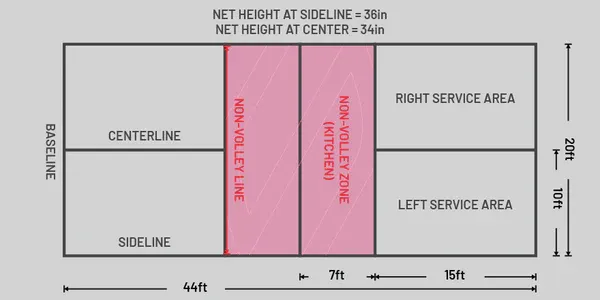
Serving Up Success: Basic Serving Rules
In pickleball, serving rules are crucial and set the stage for how each point is played. A serve must be delivered underhand and must cross the net diagonally to the opponent's service area. Each team gets one serve attempt per point, making every serve a critical opportunity to gain an advantage.
Understanding service faults is just as vital as knowing how to serve. Common mistakes include failure to serve diagonally, serving out of bounds, or stepping into the non-volley zone during the serve. These faults can turn the game's momentum and lead to lost points. Proper practice of your serving technique can be likened to a musician mastering their instrument each serve adds to the rhythm of the game and can keep the pressure on your opponents.
The Double Bounce Rule Explained
One of the most intriguing aspects of pickleball is the double bounce rule, which states that the ball must bounce once on each side before volleys are permitted. This rule seeks to foster longer rallies and allows players to establish play strategies on the court.

When the ball is served, it must first bounce once in the service area before the receiving team can return it. Likewise, the receiving team's return must bounce again on the server's side before any volleys can occur. This mechanism ensures that both players have the chance to get settled as the game unfolds. For many players, this is a grace period a moment to strategize.
Respecting this rule can add depth to your game and enhance your team’s performance. Mastering the double bounce rule encourages thoughtful play and patience attributes that can make or break a game in pickleball mixed doubles.
Communication is Key in Mixed Doubles
Amidst the fast-paced action of a mixed doubles pickleball game, effective communication can be the lifeline that keeps teamwork afloat. The ability to share information and respond to each other’s moves is critical, allowing for a stronger partnership.
Why Talking on the Court Prevents Fights (and Wins Points!)
In the heat of competition, the chatter on the court may seem insignificant, but it's profoundly impactful. Clear communication is what transforms a pair of individual players into a unified team. It serves to convey crucial information quickly, such as shot direction, anticipated plays, and movement intentions, paving the way for smoother interactions.
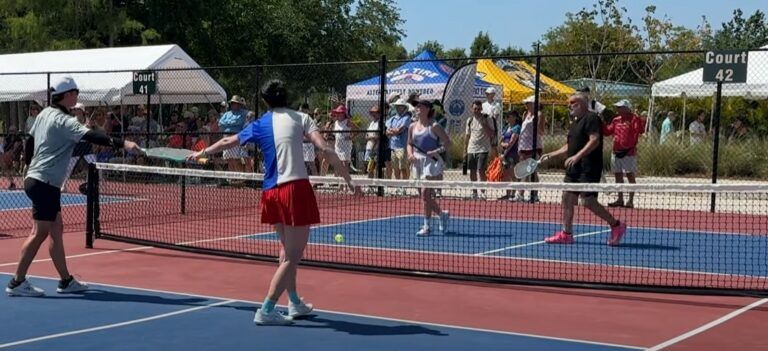
For instance, saying “Mine!” or “Yours!” before a shot can help prevent confusion and collisions. When a player confidently calls the ball, it fosters an environment where both partners can adapt and execute their strategies without hesitation. In a sport where every second counts, consistent communication can drastically improve your chances of winning points while avoiding potential mishaps.
Essential Verbal Cues
Paying attention to verbal cues is essential in competitive play. These cues allow players to calm the storm when chaos arises. A simple mechanism of calling "clear" when ready to serve or “switch” during a repositioning can streamline your team's operations. Listed below are some essential verbal cues worth practicing:
- “Mine” - Means you are taking responsibility for the shot.
- “Yours” - Indicates your partner should take the shot.
- “Back” - Signals your partner to move back in case of a deep return.
- “Switch” - Suggests a change in positions or responsibilities.
Ensuring that both players are well-versed in these calls not only builds confidence but also nurtures trust between partners. When partners know what to expect from each other based on consistent communication, it enhances their ability to strategize and execute on the fly.
Beyond Words: Non-Verbal Signals and Paddle Taps
In pickleball, communication transcends mere words. Non-verbal signals such as paddle taps or hand gestures can prove invaluable, particularly in high-pressure situations. A quick tap of the paddle can mean a player is ready for the next serve or has confidence in an upcoming play.
Furthermore, players can utilize hand signals to indicate various strategies without alerting the opposing team. For example, a raised hand might indicate a desire for a reset on the next shot, while a specific gesture could suggest implementing a particular play. This type of communication is the proverbial silent language that fosters teamwork and elevates gameplay.
Positioning Power: Where to Stand and When to Move
Positioning is a cornerstone of effective play in pickleball mixed doubles. Understanding where to stand and when to move can make a dramatic difference in your team's overall performance.
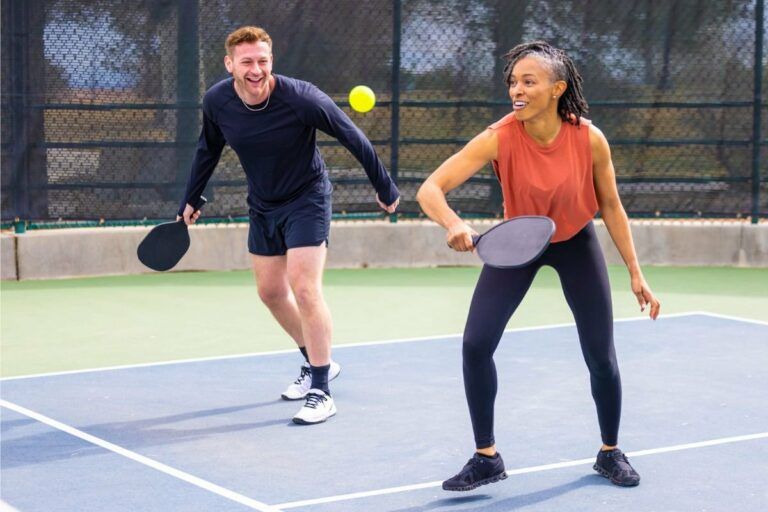
Left Side, Right Side: The Mixed Doubles Setup
In a typical mixed doubles set, positions are usually defined by player strengths and weaknesses. Generally, a left-side player (often left-handed) will take on the left side of the court, while the right-side player will dominate the opposite side. This strategic placement allows players to maximize their strengths and increase their ability to respond effectively to shots.
The dominant player may find it advantageous to consistently position themselves where they can best execute their strengths. For example, if a player has a powerful backhand, positioning closer to the baseline allows an opportunity for booming returns and aggressive shots. This strategic element is akin to a chess match a strategic setup can lead to a triumph on the court.
Your Court, My Court: Understanding Lane Responsibilities
Next, understanding lane responsibilities is critical. Each player must take ownership of their area while also knowing when to cover for a partner who may be out of position. Effective communication is paramount here; visualizing your partner's anticipated movements can lead to smoother play.
Creating a balance in court coverage minimizes gaps that opponents could exploit. Clear lanes encourage dynamic play but also rely on trust and awareness. When both players operate in sync, they create a formidable wall of defense and a potent offense, leading to uninterrupted offensive or defensive strategies.
Moving as One: The Importance of Shifting Together
As much as positioning matters, knowing how to shift together as a cohesive unit can take your game to the next level. Whether transitioning from offense to defense or adjusting positions to cover an opponent's powerful shot, moving as one reflects a well-orchestrated unit.
For example, if one partner is caught out of position, the other must adjust quickly to cover their area. Great teams possess an innate ability to read each other's movements it's an instinctive dance on the court. This kind of synchronization can be the difference between winning a match or succumbing to an opponent's aggressive plays.
The Art of Stacking: A Step-by-Step Guide
As players grow in skill, they might come across a strategy called stacking. This advanced technique can maximize strengths while conveying tactical advantages throughout a match.
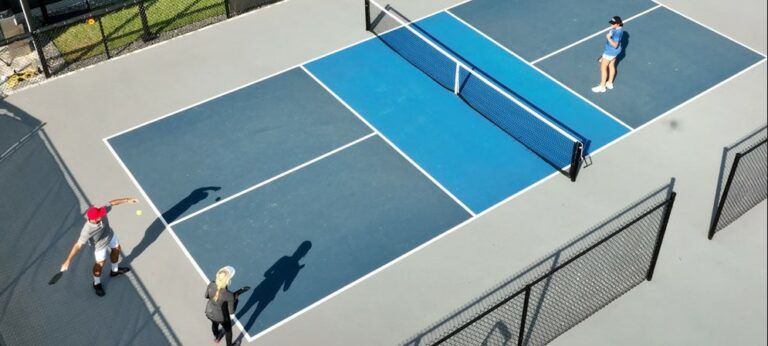
What is Stacking and Why Do We Do It?
Stacking requires both players to organize themselves in an unconventional way where partners position themselves on the same side of the court during service. This gives flexibility for either player to play from either position once the ball is in play.
Typically, this strategy is employed to allow a player to maximize their strengths, such as a powerful forehand or a strong backhand, based on what side of the court they would play from. The beauty of stacking lies in its ability to keep opponents guessing while also allowing a player to maintain their strengths without compromise.
Mastering the Half-Stack on Serves
The half-stack technique comes into play during the serve, allowing one partner to start at the net while the other plays further back. This arrangement gives the player at the net a closer position for potential volleys after the service, creating an immediate advantage for transitional plays following the serve.
To execute the half-stack effectively, communication is key it hinges on clarity regarding who will take the initiative post-serve. It’s essential to practice this technique until comfortable, ensuring you can flow smoothly into the next play without hesitation.
Level Up Your Game: The Full Stack on Returns
The full stack, a more advanced maneuver, occurs on the return of serve. It allows for an aggressive positioning strategy where both players position themselves close together before the ball is returned. With one player serving while the other readies for an aggressive return, this setup can create many exciting scoring opportunities.
Deciding whether to full stack relies on the dynamics of your partnership along with analyzing the opponents' vulnerability to varying play styles. The right call can significantly alter the rhythm of the game and challenge opponents’ strategies.
The Third Shot: Transitioning from Defense to Offense
The third shot is a pivotal moment in a pickleball rally it has the potential to dictate control of the game. Understanding how to utilize this shot can elevate the dynamic between partners.
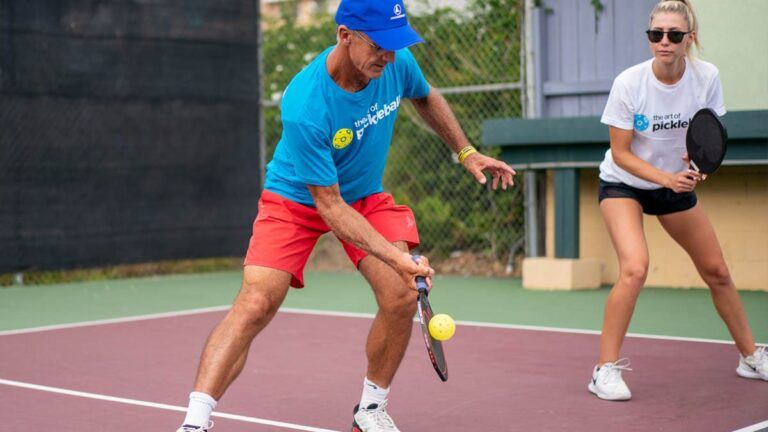
The Third Shot: Your Ticket to the Kitchen
Often known as the shot that defines a rally, the third shot is an opportunity for a player to transition from defense to offense effectively. If done correctly, this shot allows players to gain an advantage by advancing toward the kitchen for a strategic position.
This shot can either be a drop shot, which aims to softly land in the kitchen area, or a drive shot, which aggressively accelerates toward the opponent. Selecting the appropriate technique hinges on assessing the opponents’ court positioning will they be ready for a quick return, or will they be caught off guard?
Drop It or Drive It: Choosing Your Third Shot
Choosing between a drop shot or a drive shot can often create dramatic shifts in gameplay dynamics. A drop shot can catch opponents by surprise, inviting them into the kitchen unexpectedly, while a drive shot asserts pressure.
For example, if your opponent appears rushed, a drop shot may allow you to seize control. Conversely, if they lag back, a drive can set up an aggressive follow-up on returns.
Advance with Confidence: Moving Up After Your Shot
Once you execute your third shot, immediate movement towards the net is crucial. This creates an aggressive forwarding presence, putting pressure on the opponents and reinforcing your control of the game.
Moving forward after the shot allows for immediate reaction and gives you an edge in initiating the next volley. Confidence in your movements is essential timing and precision will enhance your overall effectiveness as a team.
Returning Serve Like a Pro
Effective return strategies can turn the tide of a game and set the tone for a successful partnership. Understanding how to effectively manage returns can create openings for your team.
Give Yourself Time: The Power of a Deep Return
One vital tip for returning serve is to focus on executing a deep return, sending the ball toward the back of the court. This tactic buys time, allowing your team to reposition effectively while also putting distance between you and your opponents.
When a return is deep, it forces opponents to adjust and gives you time to prepare for the upcoming rally. This strategy mimics the tactics of experienced players and can help you control the pace of the game.
Up the Middle: The Best Return for Optimal Positioning
Returning the serve up the middle is often an underrated strategy that can lead to a highly effective positioning advantage. This type of return can limit your opponent’s options, forcing them to make hurried decisions and reducing their chances of executing successful plays.
Utilizing this strategy aids in simplifying your teammates' roles on the court while also establishing a reliable and predictable return pattern that disrupts your opponents’ rhythm.
React and Adapt: Adjusting Based on Your Partner's Return
Flexibility is key in pickleball your response to your partner’s return can significantly affect the outcome of a play. Being alert, listening, and communicating swiftly will help both players adjust their positioning accordingly.
In moments where your partner's shot presents an opportunity for improvement, emphasizing practice and understanding can facilitate growth as a team. Learning to read each other’s body language while responding to your partner's actions is imperative for cohesive gameplay.
Don't Be a Target: Strategies for the "Weaker" Player
In mixed doubles, there’s often a tendency to target perceived 'weaker' players, creating an uphill battle. However, knowing how to counter these tactics can change the narrative.
Expect the Unexpected: You Will Be Targeted
Understanding that you may be targeted during matches is an essential mental preparation strategy. Often, opponents will aim their shots toward the perceived weaker player, attempting to exploit weaknesses.
Preparing mentally for this reality means anticipating shots, staying attentive, and cultivating resilience. If you can mitigate the pressure of being the targeted player, you can instead use this as an opportunity to showcase your abilities.
The Dreaded Crosscourt Dink: Survival and Counter-Attack Strategies
In the heat of competition, an opponent may employ the crosscourt dink shot, which requires a tactical response from the targeted player. The objective of this strategy is to create uncomfortable situations and force errors.
Having a plan in place to counter inching volleys can empower the weaker player to turn the tables. Use the soft dinks to build strategy rather than playing defensively, creating opportunities to catch opponents off-guard instead.
Mix It Up: Don't Be Predictable
Keeping your shots unpredictable can frustrate opponents aiming for the “weaker” player. Making use of various shot types such as topspin lobs or unexpected drop shots can keep opponents guessing.
Moreover, varying the speeds and depths of your shots can create confusion, further enhancing your ability to sidestep opponents' plans while establishing your rhythm.
The Dominant Player's Playbook: Leading with Support
In every team, there is usually a dominant player who may take the lead in play. Understanding how to navigate this role effectively can lead to stronger team dynamics and a more fruitful gameplay experience.
When to Step In (and When to Stay Put)
The dominant player must learn the art of judgment knowing when to take charge can set the tempo of the game. Conversely, understanding when to step back is equally important to create balance within the partnership.
A well-timed intervention can secure a winning point or avoid confusion, establishing the partnership as a well-oiled machine. Mutual support in navigating these dynamics encourages camaraderie and enables smooth gameplay.
Clear and Constant Communication is Essential
As with any team sport, clear communication allows for the dominant player to lead effectively while still acknowledging the contributions of their partner. Verbal cues and non-verbal signals act as frameworks upon which both players can rely, minimizing confusion through clarity.
In moments of uncertainty, reinforcing the strategy with simple, decisive commands can prevent breakdowns while maintaining momentum. It is essential to nurture a culture of communication to facilitate teamwork.
Finding the Balance: Aggression vs. Support
Embracing both aggression and support as a dominant player can create a formidable coalition. While leading, it’s equally crucial not to overshadow your partner; creating shared responsibility fosters a positive atmosphere.
This balancing act encourages both players to contribute equally while avoiding “ball hog” tendencies. Celebrating shared successes and remaining focused on team dynamics will enhance the overall experience for both players.
Building a Winning Mindset: More Than Just Rules
In designing a successful approach to mixed doubles, the mindset of the players is often more influential than the rules themselves. Positive attitudes contribute enormously to performance and enjoyment.
Patience and Positivity: Keys to Mixed Doubles Success
Patience and a positive mindset can alter the trajectory of a game. Adopting these principles invites resilience and enthusiasm, allowing players to embrace challenges while promoting enjoyment.
A positive outlook can act as a buffer against frustrations, enabling players to bounce back rather than dwell on shortcomings. In this way, building a winning mindset transcends the rules of the game, becoming an essential component of your pickleball journey.
Mistakes Happen: Supporting Each Other Through Challenges
Every player makes mistakes that’s an inherent part of sports. Emphasizing constructive feedback rather than focusing on faults fosters a productive environment that builds respect and trust.
When both partners aid each other in navigating challenges, it creates opportunities for improvement and shared learning. This collaborative approach strengthens teamwork while fostering individual growth along the way.
Celebrate the Wins: Big and Small
No matter how small a victory may seem, celebrating wins can reinforce team morale. Recognizing achievements, both minuscule and monumental, fosters a supportive environment where players feel valued.
By sharing these moments of joy, teams build stronger bonds and raise their motivation, infusing energy into their subsequent games. Whether it’s a great shot or a strategic play, every win deserves recognition.
Take Your Game to the Next Level: Resources and Tips
Stepping up your pickleball game requires awareness of the right resources and educational opportunities available to you.
The Official Rulebook: USAPA Guidelines
To ensure that you are adhering to the most up-to-date USAPA rules, familiarizing yourself with the official rulebook is paramount. Integration of these guidelines informs your gameplay while ensuring fair competition within leagues and tournament settings.
Continually referencing the rulebook fosters confidence, allowing players to navigate the nuances of mixed doubles more adeptly, thus enhancing their overall sport experience.
Learn from the Pros: Recommended Videos for Beginners
Watching instructional videos allows beginners to absorb valuable insights from seasoned players. Whether mastering a specific serve or understanding court dynamics, video tutorials can spark inspiration and develop techniques crucial for improved performance.
Seek out several expert-endorsed videos that cover various aspects of pickleball, ensuring to incorporate those lessons into practice sessions.
Find Your Pickleball Community: Clubs and Clinics
Engaging with local pickleball clubs or clinics provides an active support network for players. This community atmosphere nurtures friendships, and practice opportunities boost learning experiences while participating in leagues and recreational activities.
Involvement not only enhances skills but also fosters a sense of belonging, further enriching the journey in pickleball.
As you embark on your journey into mixed doubles pickleball, remember that while the rules lay the foundation for play, it is your passion, persistence, and positive mindset that will ultimately illuminate your path to becoming a proficient player. Enjoy the game, appreciate the lessons, and connect deeply with grace and determination. With every rally, just like life, it's all part of the beautiful game.










